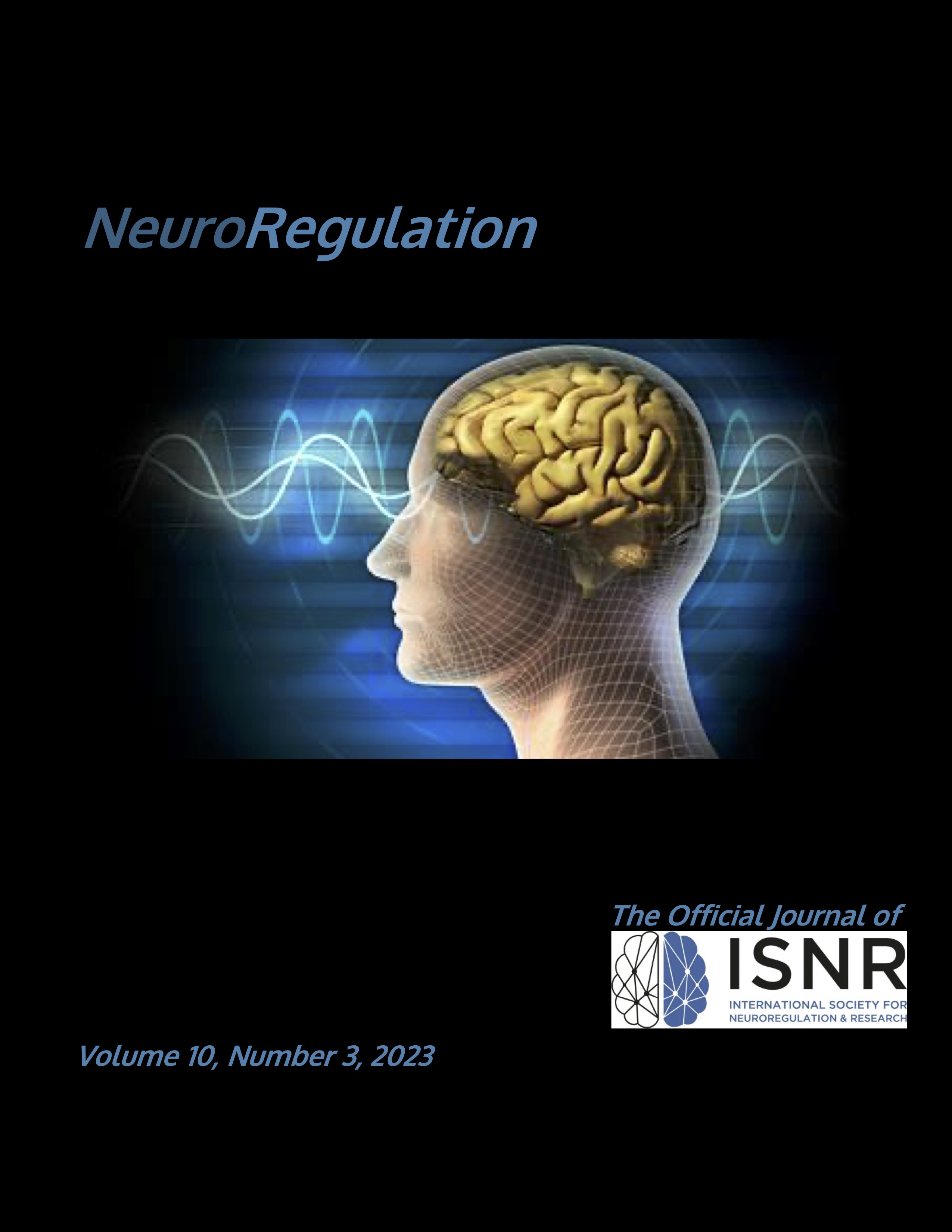Exploring Single-Case Research Design With Individualized Anxiety-Based Neurofeedback Protocols and Session Data
DOI:
https://doi.org/10.15540/nr.10.3.159Keywords:
neurofeedback, ssingle-case research design,, anxietyAbstract
Individuals’ experiences of anxiety differ in manifestation, development, and severity. Using retrospective neurofeedback session data which included quantitative electroencephalography (qEEG)-based anxiety protocols, we examined four participants’ data. We employed a single-case research design (SCRD) methodology to highlight the individual variations or change across participants’ neurofeedback session data. We assessed effect size using visual analysis, nonoverlap of all pairs, and simulation modeling analysis. Considering the novel concept of applying SCRD to physiological data, we compare and contrast our findings while also suggesting limitations and future areas for research.
References
American Psychiatric Association. (2022). Diagnostic and statistical manual of mental disorders (5th ed., text rev.). https://doi.org/10.1176/appi.books.9780890425787
Borckardt, J. J. (2006). SMA time series analysis program for short time series data streams (Version 8.3.3.) [MacOS 64-Bit]. http://www.clinicalresearcher.org/software.htm
Carpenter, J. K., Andrews, L. A., Witcraft, S. M., Powers, M. B., Smits, J. A. J., & Hofmann, S. G. (2018). Cognitive behavioral therapy for anxiety and related disorders: A meta-analysis of randomized placebo-controlled trials. Depression and Anxiety, 35(6), 502–514. https://doi.org/10.1002/da.22728
Cheon, E.-J., Koo, B.-H., Seo, W.-S., Lee, J.-Y., Choi, J.-H., & Song, S.-H. (2015). Effects of neurofeedback on adult patients with psychiatric disorders in a naturalistic setting. Applied Psychophysiology and Biofeedback, 40(1), 17–24. https://doi.org/10.1007/s10484-015-9269-x
Delpino, F. M., da Silva, C. N., Jerônimo, J. S., Mulling, E. S., da Cunha, L. L., Weymar, M. K., Alt, R., Caputo, E. L., & Feter, N. (2022). Prevalence of anxiety during the COVID-19 pandemic: A systematic review and meta-analysis of over 2 million people. Journal of Affective Disorders, 318, 272–282. https://doi.org/10.1016/j.jad.2022.09.003
Fielenbach, S., Donkers, F., Spreen, M., & Bogaerts, S. (2019). The ability of forensic psychiatric patients with substance use disorder to learn neurofeedback. International Journal of Forensic Mental Health, 18(3), 187–199. https://doi.org/10.1080/14999013.2018.1485187
Ganz, J. B., & Ayres, K. M. (2018). Methodological standards in single-case experimental design: Raising the bar. Research in Developmental Disabilities, 79, 3-9. https://doi.org/10.1016/j.ridd.2018.03.003
Gregory, J. C. (2022). Using a neuro-ecological approach: Individualized neurofeedback for the treatment of alcohol use disorder. [Doctoral dissertation, University of Texas at San Antonio].
Gregory, J. C., Romero, D. E., & Jones, M. S. (2020). Predictors of neurofeedback outcomes following qEEG individualized protocols for anxiety. NeuroRegulation, 7(1), 18–25. https://doi.org/10.15540/nr.7.1.18
Jones, M. S. (2015). Comparing DC offset and impedance readings in the assessment of electrode connection quality. NeuroRegulation, 2(1), 29–36. https://doi.org/10.15540/nr.2.1.29
Kazdin, A. E. (2021). Single‐case experimental designs: Characteristics, changes, and challenges. Journal of the Experimental Analysis of Behavior, 115(1), 56–85. https://doi.org/10.1002/jeab.638
Kratochwill, T. R., Horner, R. H., Levin, J. R., Machalicek, W., Ferron, J., & Johnson, A. (2023). Single-case intervention research design standards: Additional proposed upgrades and future directions. Journal of School Psychology, 97, 192–216. https://doi.org/10.1016/j.jsp.2022.12.002
La Vaque, T. J., Hammond, D. C., Trudeau, D., Monastra, V., Perry, J., Lehrer, P., Matheson, D., & Sherman, R. (2002). Template for developing guidelines for the evaluation of the clinical efficacy of psychophysiological interventions. Applied Psychophysiology and Biofeedback, 27(4), 273–281. https://doi.org/10.1023/A:1021061318355
Ledford, J., Lane, J., & Severini, K. (2018). Systematic use of visual analysis for assessing outcomes in single case design studies. Brain Impairment, 19(1), 4–17. https://doi.org/10.1017/BrImp.2017.16
Lenz, A. S. (2015). Using single-case research designs to demonstrate evidence for counseling practices. Journal of Counseling and Development, 93(4), 387–393. https://doi.org/10.1002/jcad.12036
Lobo, M. A., Moeyaert, M., Cunha, A. B., & Babik, I. (2017). Single-case design, analysis, and quality assessment for intervention research. Journal of Neurologic Physical Therapy, 41(3), 187–197. https://doi.org/10.1097/NPT.0000000000000187
Manolov, R., & Solanas, A. (2018). Analytical options for single-case experimental designs: Review and application to brain impairment. Brain Impairment, 19(1), 18–32. https://doi.org/10.1017/BrImp.2017.17
National Institute of Mental Health. (2017). Any anxiety disorder. https://www.nimh.nih.gov/health/statistics/any-anxiety-disorder#part_2576
National Institute of Mental Health. (2023, April). Anxiety disorders. https://www.nimh.nih.gov/health/topics/anxiety-disorders#part_2222
Parker, R. I, & Vannest, K. (2009). An improved effect size for single-case research: Nonoverlap of all pairs. Behavior Therapy, 40(4), 357–367. https://doi.org/10.1016/j.beth.2008.10.006
Tanaka-Matsumi, J., & Kameoka, V. A. (1986). Reliabilities and concurrent validities of popular self-report measures of depression, anxiety, and social desirability. Journal of Consultation and Clinical Psychology, 54(3), 328–333. https://doi.org/10.1037/0022-006X.54.3.328
Walker, J. E. (2012). Remediation of enuresis using QEEG-guided neurofeedback training. Biofeedback, 40(3), 109–112. https://doi.org/10.5298/1081-5937-40.3.04
Wigton, N. L., & Krigbaum, G. (2015). A Review of qEEG-guided neurofeedback. NeuroRegulation, 2(3), 149–155. https://doi.org/10.15540/nr.2.3.149
Zung, W. (1971). A rating instrument for anxiety disorders. Psychosomatics, 12(6), 371–179. https://doi.org/10.1016/S0033-3182(71)71479-0
Downloads
Published
Issue
Section
License
Copyright (c) 2023 J. Claire Gregory, Devon E. Romero, Mark S. Jones

This work is licensed under a Creative Commons Attribution 4.0 International License.
Authors who publish with this journal agree to the following terms:- Authors retain copyright and grant the journal right of first publication with the work simultaneously licensed under a Creative Commons Attribution License (CC-BY) that allows others to share the work with an acknowledgement of the work's authorship and initial publication in this journal.
- Authors are able to enter into separate, additional contractual arrangements for the non-exclusive distribution of the journal's published version of the work (e.g., post it to an institutional repository or publish it in a book), with an acknowledgement of its initial publication in this journal.
- Authors are permitted and encouraged to post their work online (e.g., in institutional repositories or on their website) prior to and during the submission process, as it can lead to productive exchanges, as well as earlier and greater citation of published work (See The Effect of Open Access).











